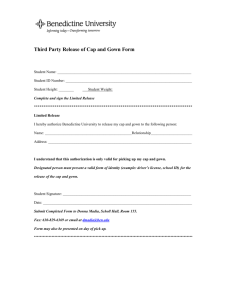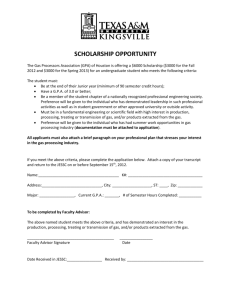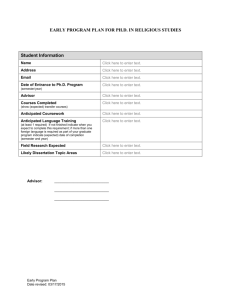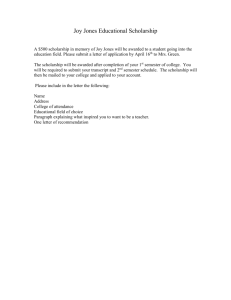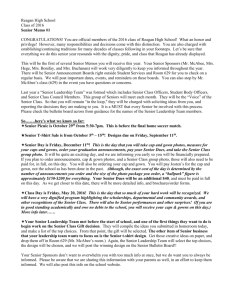File - Professional E- Portfolio Dominique M. Starr
advertisement
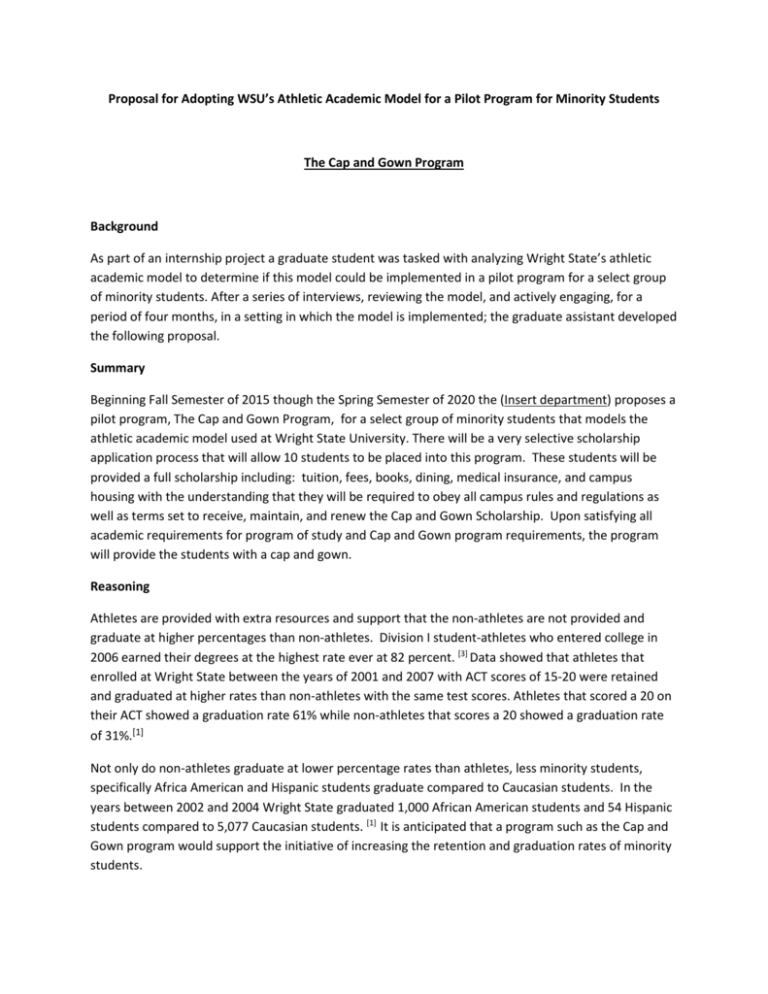
Proposal for Adopting WSU’s Athletic Academic Model for a Pilot Program for Minority Students The Cap and Gown Program Background As part of an internship project a graduate student was tasked with analyzing Wright State’s athletic academic model to determine if this model could be implemented in a pilot program for a select group of minority students. After a series of interviews, reviewing the model, and actively engaging, for a period of four months, in a setting in which the model is implemented; the graduate assistant developed the following proposal. Summary Beginning Fall Semester of 2015 though the Spring Semester of 2020 the (Insert department) proposes a pilot program, The Cap and Gown Program, for a select group of minority students that models the athletic academic model used at Wright State University. There will be a very selective scholarship application process that will allow 10 students to be placed into this program. These students will be provided a full scholarship including: tuition, fees, books, dining, medical insurance, and campus housing with the understanding that they will be required to obey all campus rules and regulations as well as terms set to receive, maintain, and renew the Cap and Gown Scholarship. Upon satisfying all academic requirements for program of study and Cap and Gown program requirements, the program will provide the students with a cap and gown. Reasoning Athletes are provided with extra resources and support that the non-athletes are not provided and graduate at higher percentages than non-athletes. Division I student-athletes who entered college in 2006 earned their degrees at the highest rate ever at 82 percent. [3] Data showed that athletes that enrolled at Wright State between the years of 2001 and 2007 with ACT scores of 15-20 were retained and graduated at higher rates than non-athletes with the same test scores. Athletes that scored a 20 on their ACT showed a graduation rate 61% while non-athletes that scores a 20 showed a graduation rate of 31%.[1] Not only do non-athletes graduate at lower percentage rates than athletes, less minority students, specifically Africa American and Hispanic students graduate compared to Caucasian students. In the years between 2002 and 2004 Wright State graduated 1,000 African American students and 54 Hispanic students compared to 5,077 Caucasian students. [1] It is anticipated that a program such as the Cap and Gown program would support the initiative of increasing the retention and graduation rates of minority students. Current WSU Athletic Academic Model: 1. Staffing a. Two full time academic advisors b. One learning specialist that works with the athletes one on one with tutoring and basic learning skills and techniques c. Student tutors and study coaches 2. Study Tables and Tutoring a. All first year student-athletes at WSU are required to complete at least 6 study table hours a week, this includes tutoring. b. After the first year, the advisors will implement study table hours based on the academic performance of the individual athlete and/ or by the required hours coaches have in place for their teams. 3. Advisor Meetings a. Based on the academic performance of the athlete some athletes are required to meet with one of the advisors or learning specialist once a week, every other week, every day, or several times a week. 4. Pilot Access and Grade Sheets a. The advisors can access the student’s grades on pilot in the case the students forget or do not provide the advisors with their assignments and grades. b. One of several duties these advisors have is keeping track of the student athletes’ grades. One advisor keeps grades sheets for her assigned teams. These sheets contain all the student’s classes and assignments and as the student’s grades come in the advisor records them. This allows the advisors to intervene early with academic support if needed. The Cap and Gown Program Staff Advisor o Help students decide the classes they need to take o Keep track of the students’ progress in each class o Keep track of the students’ progression toward intended degree o Conduct advisor meetings o Monitor student compliance in regards to terms of the scholarship Tutors and Study Monitors o Tutors will be selected on a need basis o Study monitors will supervise study tables to ensure the students are studying without any disruptions Structure Advisor Meetings o Each student will be required to meet with the advisor at least once a week for the first semester. After the first semester the advisor can decide the frequency of the meetings depending on the student’s academic performance. Study Tables and Tutoring o Each student will be required to attend at least 6 hours of study table hours or tutoring hours per week. Internships and shadowing o The second semester the students will be required to shadow a professional in the field the student intends to work for at least 12 hours o The students will also be required to complete at least 50 internship hours in their intended professional field before their senior year. Community Service o The group will be required to complete at least 20 hours of community service per semester Mentorship o Mentors will be matched with the students that wish to have one Cap and Gown Scholarship The Cap and Gown Scholarship will be awarded to a hand selected group of minority students that display merit and financial need. The scholarship requirements and process are as follows: Requirements 2.5 -3.5 high school GPA 18-22 ACT Score Have not missed more than 10 days of school all four years unless related to serious illness or certain family circumstance. Student allowed to explain situation 500 word essay 3 reference sheets from people that can speak on the student’s academic potential Scholarship Process for the Program Apply Interview with Cap and Gown Committee Committee selects 10 applicants to be accepted in the program Terms for maintaining scholarship Maintain at least a 2.5 gpa Attend required advisor meetings , meet required study table/ tutoring hours, community service and internship hours, and show participation in events and activities hosted by the program and department Comply with all university rules and regulations Housing Cost- The program will provide funds for housing as long as the student resides in campus housing Failure to meet any of the above terms may result in revocation of the scholarship Cost Associated with the Program An excel sheet is attached that list the cost per year for tuition, housing, and fees and tutors Assessment A focus group will be conducted with the group after each semester and exit interviews will be conducted with each student upon completion of the program References 1. Wright State University. Access, Progress, Success Recommendations for Increasing Retention and Graduation in the Semester Transition. 2012 2. Wright State University Dayton Campus, New Direct from High School African- American Students Fall 2013 Profile. Office of Institutional Research. K:\ir\Aaron\Colleges\UC\Advising & Transfer Services/Fall 2013/African-American New Student Profile. 10/2/2013 3. Hosick, M. 2013. Division I student-athletes make the grade. http://www.ncaa.org/about/resources/media-center/news/division-i-student-athletes-makegrade
